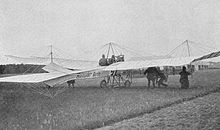Hans Robert Vollmöller

Hans Robert Vollmöller (born March 6, 1889 in Stuttgart , † March 10, 1917 in Staaken ) was an important pioneer of the first phase of German aviation together with his brother Karl Gustav Vollmoeller, who was eleven years older than him .
Life
Hans was a son of the industrialist Robert Vollmöller and the social reformer Emilie Vollmöller . At the age of 15, he and his older brother Karl, who was also the designer of the four “Vollmöller” aircraft, started building the first German motor-powered aircraft in Vaihingen . At the age of 16 he learned to fly in 1905. Hans Robert Vollmöller had an unusual gift for flying; two years later he competed in the first flying competitions in Germany and other European countries and won numerous trophies. In the summer of 1910, the Vollmöller brothers made their first long-haul flight from Bad Cannstatt . It led over around 150 km to Lake Constance near Konstanz. After an accident in the autumn of 1910 in which a spectator was killed, the Vollmöller brothers stopped building their own aircraft. The last model, No. 4, is in the Flugwerft of the Deutsches Museum.
In 1911 Hans Robert Vollmöller went to Berlin to work as a designer and test pilot for the Edmund Rumpler company. Johannes von Guenther writes: ... “Hans was an aviator and worked for the Rumpler company, which was based in Johannistal, Berlin's air traffic control center. In 1911 a new airplane model was just being tried out there, the later famous pigeon ”. In the same year he received his pilot license with the number 84 on May 15, 1911.
In 1914 Vollmöller was drafted at the beginning of the war and worked in the design team of Hellmuth Hirth and Bosch director Gustav Klein , which had been in existence since 1913 . With the further participation of Graf Zeppelin it became the "Versuchsbau GmbH Gotha-Ost" (VGO) in 1914. The designers were Prof. Dr. Alexander Baumann , as well as the engineers Hermann and Scholler, who had set themselves the goal of developing a "giant airplane".
Theodor Heuss writes: “[...] later the activity was transferred to the suitable airship yard in Staaken near Berlin ... the main constructive work was done by a serious scientist, Professor Dr. A. Baumann from the Stuttgart University of Applied Sciences, alongside him the aviation specialists such as Hirth, Vollmoeller, temporarily also Ernst Heinkel ... The giant aircraft, "says Heuss," left all the dimensions previously known in international aviation far behind: equipped with three 240 hp Maybach engines it reached a span of 43 meters and could carry 3000 kg payload. "
As chief pilot led Hans Robert Vollmöller on 10 March 1917 a test flight with the first of the giant aircraft, the VGO I carried. Heuss: “It was an adverse, cold and windy day - instead of ten o'clock you got to the start at two o'clock, the gates of the hall had become bulky due to the cold. But they did not want to postpone the attempt. He failed; the plane, on its return from its scenic flight over the field, hit a corner gate of the hangar and crashed into pieces. The Führer, the young Vollmöller, died immediately. ”Gustav Klein also died in the accident. Hans Robert Vollmöller was transferred from Berlin to Stuttgart and buried there.
literature
- Theodor Heuss : Robert Bosch. R. Wunderlich Verlag, Tübingen 1946.
- Johannes von Guenther : A life in the east wind. Biederstein Verlag, Munich 1969.
- Frederik D. Tunnat: Karl Vollmöller. Poet and cultural manager. A biography. tredition, Hamburg 2008, ISBN 978-3-86850-000-4 .
Web links
Individual evidence
- ^ Henry Serrano Villard: Contact !: The Story of the Early Aviators . Courier Corporation, Mineola, NY 2002, ISBN 0-486-42327-1 , pp. 257 (English, limited preview in Google Book search).
- ↑ Bruno Lange: Type manual of German aviation technology. 1986, p. 88.
- ^ Johannes Bähr / Paul Erker, Bosch. History of a global company ; Munich 2013
- ↑ Photo of the machine destroyed in the crash
| personal data | |
|---|---|
| SURNAME | Vollmöller, Hans Robert |
| BRIEF DESCRIPTION | German aviation pioneer |
| DATE OF BIRTH | March 6, 1889 |
| PLACE OF BIRTH | Stuttgart |
| DATE OF DEATH | March 10, 1917 |
| Place of death | Staaken |